The Museum Collections
Introduction
I. History and Art Collection
1. Icons of the 14th – 19th centuries
icons of the 14th – 17th century
2. Jewelry art of the 14th – 20th century
jewelry art of the 14th – 17th century
jewelry art of the 18th – 19th century
the european silver 14th - 19th centuries
3. Small-size sculptures (works of metal, wood, bone)
XI – the beginning of the XX century
Small-size sculptures 11th – 17th century
Small-size sculptures 18th – early 20th century
enamel of Troitza masters 15-8th – early 20th century
5.Embroidery, lace, textiles of the 14th - early 20th century
icon and ornamental embroidery
gold and silver lace
6.Painting of the 18th – 21st centuries
painting of the 18th – 19th centuris
painting of the 20th – 21st centuris
II.Manuscripts and old printed books of the 14th – 17th century
IV.Lithography of the 18th – 19th century
V.Numismatics
VI.Medals of the 18th - early 20th century
VIII.Archeology collection
IX. Russian folk and applied and decorative art of the 17th – 21st c.
1. Artistic wood
folk carved and painted wood
wooden toys
house carving of Sergiev Posad
Khokhloma and Gorodets painting
2. Artistic textiles
embroidery and weaving
printed textiles and lace
Russian shawls
folk costumes
folk garments
printed cotton kerchiefs
|
Icon and Ornamental Embroidery of the 14th – 19th Centuries (page 2) |
|
T he icon-cloth showing “Church Feasts and Selected Saints” of 1499 was made “to the conception and order of Tsarina of Constantinople and Grand Princess of Moscow Sophia” who was the second wife of Moscow Grand Prince Ivan III. The icon-cloth demonstrates a peculiar technique: multi-colored or gold and silver spots thickly covering the saints’ clothes, earth and architectural structures. This technique reflects the tastes of the workshop owner – “tsarina of Constantinople”. Sophia apparently presented other works simultaneously with the icon-cloth.
|
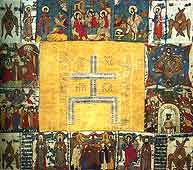
Church Feasts and Saints. Icon-cloth. 1499. Donated by Grand Princess Sophia Paleologus |
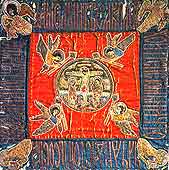
The Crucifixion. Purificator. Late 15th century.Donated by Grand Princess Sophia Paleologus |
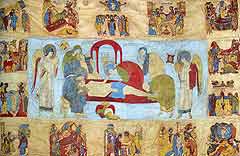
The Entombment and Feasts. Shroud. Late 15th century
|
The surviving Moscow monuments of the 15th century demonstrate great skill in gold and silver thread and multi-colored silk embroidery. However, till the first quarter of the 16th century colored silk threads were preferred. One of the most beautiful samples of that time is the purificator representing “The Miracle of Archangel Michael in Konya”. It still strikes with bright color scheme. The embroideries of the late 15th – early 16th centuries are noticeably influenced by Dionysius art.
Two small icon-clothes – “The Virgin of the Sign” and “St. Nicholas” are distinguished by the elegant elongated proportions, noble images, refined color range. “The Virgin of the Sign” is embroidered exclusively in gold and silver threads. The features of Dionysius art are most evident in embroideries made in the royal workshop of Vasily III and his wife Solomonia Saburova. Donated in 1525 their icon-cloth “The Appearance of the Virgin to St. Sergius of Radonezh, Church Feasts and Saints” is marked by elongated slender figures, fine drawing, refined colors and decorativeness. The Grand Prince artists frequently drew compositions for embroideries in the boyar workshops. Thanks to the embroidered inscriptions on the pall “The Crucifixion”, donated in 1514 by Boyarynia Anastasia Ovinova, we know the names of the artists: Andrei Myvedon and Anika Grigoriyev Kuveka.
|
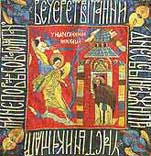
The Miracle of Archangel Michael in Konya. Purificator. Late 15th – early 16th century |
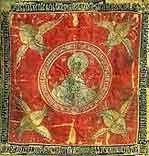
Icon-cloth. The Virgin of the Sign. Late 15th century |
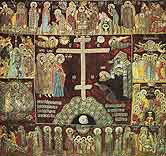
Icon-cloth. The Appearance of the Virgin to St. Sergius of Radonezh. 1525. |
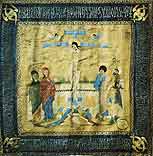
Pall. The Crucifixion. 1514.
|
In the middle and in the second half of the 16th century, the best embroideries were produced in the tsarina workshops of Anastasia Romanovna, Maria Nagaya, Irina Godunova. The pall donated in 1557 by Anastasia Romanovna, who was a skilful needlewoman herself, is marked by a rare composition and refined color scheme. In the 1580s, the monumental palls with the images of St. Sergius and St. Nikon of Radonezh were embroidered in the tsar workshops.
One of the most significant workshops in the 1550s and 1560s belonged to Princess Euphrosyne Staritskaya. The large monumental aers (shrouds) with many-figured compositions and elaborate ligature inscriptions were made there. Beautiful in design and composition, very harmonious in color scheme, they are perceived as monuments of both figurative and decorative art.
Embroidery in silk threads, stitched thickly in different directions producing light and shadow effects in faces, became more complicated. The superb technique of embroidery in silver threads, stitched down at intervals, permitted to create diverse ornaments. The embroidered inscriptions in complicated ligature are characteristic of that time. In 1561, the workshop of Euphrosyne Staritskaya produced the large aer (shroud) “The Entombment”. The embroidered donation inscription records that it was presented to the Trinity-St. Sergius Monastery by Prince Vladimir Andreyevich and his mother Euphrosyne “in memory of the last appanage family”.
|
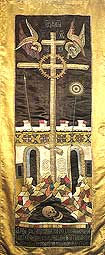
The Golgotha Cross. Pall. 1557. |
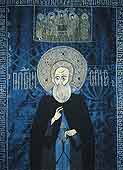
St. Sergius of Radonezh. Pall. 1581. Detail. Donated by Tsar Ivan the Terrible and Tsarina Maria Nagaya |
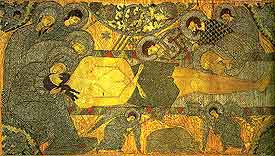
The Entombment. Shroud. 1561. Detail. Donated by appanage prince Vladimir Andreyevich Staritsky and his mother Euphrosyne.
|
In the late 16th – early 17th century, the embroidery workshops of Boris Feodorovich Godunov occupied a notable place. Preserving superb technique of embroidery in silk, gold and silver threads and high icon-painting style, the works of the Godunovs’ workshop became even more decorative. They turned into precious items due to numerous pearls, precious stones, gold and silver plaques of different shapes and sizes decorated with engraving and niello. The precious decorations were not end in themselves. The great skill always made them fall into line with complicated artistic tasks.
There were two periods in Godunovs’ embroidery. The boundary between them was 1598, when Boris was declared Tsar. The pall, depicting “The Appearance of the Virgin to St. Sergius” with the Golgotha cross in the background, is referred to 1587. Between 1598 and 1604, Boris Godunov presented the Trinity Monastery with a set of embroideries for church vessels including the purificator with the scene of “The Trinity” that followed Andrei Rublev icon in composition.
The 17th century embroidery in the Museum collection is represented by a number of interesting specimens from the tsarina workshops and the workshops of “the notable people” Stroganovs. The Stroganovs’ main donations are referred to the 1660s – 1670s. They are connected with Dmitry Andreyevich, his wife Anna Ivanovna and their son Grigory. In 1671, Anna Ivanovna Stroganova donated the pall with the image of St. Sergius to the Trinity-St. Sergius Monastery.
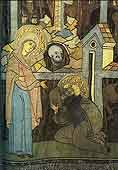
The Appearance of the Virgin to St. Sergius. Pall. 1567. Detail |

The Trinity. 1598 – 1604. Purificator. Donated by tsar Boris Godunov |
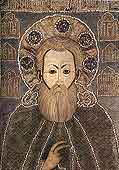
St. Sergius of Radonezh and Scenes from His Life. Pall. 1671. Detail. Donated by Anna Ivanovna Stroganova
|
|


